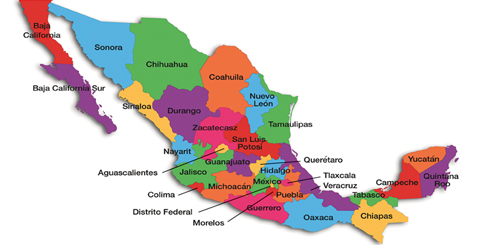Mexico is not only the top producer of limes (and lemons) in the world but the largest supplier to the United States. Mexico’s limes are grown mostly in Michoacán, Colima, Veracruz, and Oaxaca.
Other favorites
Tropical fruits, including mangos and papaya, are also hot commodities in both domestic and foreign markets, and grow in abundance in southern states like Chiapas and Oaxaca, as well as in Veracruz and Sonora.
Melons, too, flourish in Mexico’s various growing regions. Watermelon, cantaloupe, and honeydew grow principally in Guerrero, Jalisco, Colima, and Sinaloa.
The Temperate Zone
Occupying the temperate middle of the country is El Bajío, an area that sits at 5,000 to 5,900 feet above sea level. Thanks to its climate and established infrastructure, El Bajío, which means “lowlands,” is quickly expanding to become one of Mexico’s most critical growing regions.
“A big advantage of this specific region is that the weather is usually perfect for the products and the quality is high,” comments Edgar Gaona, whose father founded Chihuahua-based produce import/ export firm Frugasa S.A. de C.V.
“El Bajío, in particular, has the advantage that you can grow product almost every day of the year,” Gaona says.
Mark Vestal, president of Santa Barbara, California-based Western Pacific Produce, Inc., grows vegetables including broccoli, snow peas, carrots, and Napa cabbage in both Guanajuato and Puebla. “Because of the altitude, it’s cool and we have good growing conditions,” he explains.
Labor may be cheaper, but less mechanization means more labor. Good farmland is about the same price, and fuel costs the same, too.
Weather can be an advantage, but for some U.S. suppliers growing crops in Mexico, it’s about simplification. “It does not cost me less to do business down in Mexico,” admits Vestal, but he says it is less complicated than navigating California’s many regulations.
Protected Agriculture
As of late 2016, there were about 22,000 acres of protected agriculture in Mexico, consisting of greenhouses and various ‘protected’ structures like high tunnels or shade houses. Most of these structures can be found in the coastal states of Sinaloa, Jalisco, and Baja California.
According to the Mexican Association for Protected Horticulture, the country’s protected agriculture has been growing at an annual average rate of 3,600 acres for the past few years.
Tomatoes, cucumbers, and chiles account for the bulk of crops grown under protection, although lettuce, herbs, and bell peppers aren’t far behind.



